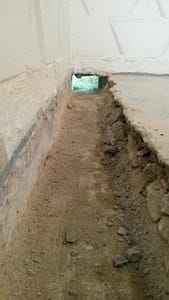See This Report on Best Basement Waterproofing
Table of Contents4 Simple Techniques For Best Basement WaterproofingSome Known Incorrect Statements About Best Basement Waterproofing Facts About Best Basement Waterproofing UncoveredThe Single Strategy To Use For Best Basement WaterproofingFacts About Best Basement Waterproofing Uncovered
uses excavation strategies toward all-time low of the framework's structure. involves eliminating dampness after it has gone into the cellar. AdvantaClean's trained professionals and specialists will certainly situate the water source. If wall or slab fractures are existing, we will inject polyurethane and epoxies into the fractures and secure the concession, avoiding additional moisture from going into.Setting up cellar air flow systems, conditioning systems, or cellar dehumidifier systems to get water out of your cellar. Selecting AdvantaClean's cellar waterproofing solutions is an effective way to deal with dampness and prevent mold from endangering the framework of your home and the wellness of your family.
If there's condensation on the outside of the foil, you have high moisture in your cellar. If the foil has condensation on the inside surface (next to the wall surface), the soil around your home may be naturally damp from a high water table or poor soil drainage.
You can waterproof just your interior walls, which may solve the problem. Or you can waterproof your outside wall surfaces, which is a far better bet yet more expensive. Here's the scoop on the various types: These thick finishes are cement-like. Once they dry, they stick completely to concrete and masonry wall surfaces.
9 Simple Techniques For Best Basement Waterproofing
Concrete waterproof finishes can't be used to formerly painted surfaces; examine the label. Known as densifiers, they are suitable just for walls that haven't been repainted or sealed.
However you comb, roll, or spray it on much even more heavily one gallon covers just 75 square feet, not the 300 square feet regular with common paint. Water-proof paint is fine for DIY application. You can use it over repainted surfaces, and paint over it once it's cured (one gallon expenses $37).
It can cost $10,000 to $15,000, depending upon the job required. Outside waterproofing includes digging deep into around the house fully deepness of the structure walls, then mounting a water resistant covering or membrane topped by drainage panels. The panels give a very easy course for water to flow to an exterior French drainpipe at the end of your structure.
The Definitive Guide to Best Basement Waterproofing
A basement without waterproofing is kind of like that. Your cellar does not want to go via a rainstorm without proper security just as much as you do not desire to.
Outside waterproofing is a waterproofing approach that entails sealing your home from the exterior. The foundation walls are then cleansed, sealed, and covered with a waterproof membrane or sealer.

The Definitive Guide to Best Basement Waterproofing
It's a more engaged procedure that needs digging up your lawn, which is costly and time-consuming. Exterior waterproofing involves removing every little thing surrounding your house, consisting of porches, driveways, sidewalks, landscaping, air conditioner systems, decks, and so on. If any one of the job was done improperly and water is still entering your basement, there isn't much you can do to correct or repair it.
Inside cellar waterproofing involves waterproofing from the inside. Any kind of water that leaks into your cellar is rerouted before it touches your flooring.
It's an effective approach to waterproof your cellar. The disadvantage of interior cellar waterproofing mainly relates to the installation procedure. This method requires stored items, furnishings, and built-in shelving or cabinets to be relocated from touching the basement walls. And throughout installation, your basement can't be used. The greatest distinction in between both techniques is this: Outside waterproofing is a preventative remedy and indoor waterproofing is a restorative option.
Best Basement Waterproofing Things To Know Before You Get This
In verdict, outside and interior cellar waterproofing are both effective methods of safeguarding your home from water damage. Outside waterproofing develops an obstacle that avoids water from entering your home, while interior waterproofing reroutes water that does enter your home. And it's important to note that outside waterproofing is a pricey and turbulent installment process when contrasted to interior waterproofing.
Whichever method you pick, ensure you pick a trusted and credible contractor for the task. Both approaches need seasoned employees to deal with the job. If you have any kind of concerns about cellar waterproofing, please reach out to you can try here us. And if you remain in our solution area and have water in your cellar, contact us for a cost-free, no-obligation home evaluation.
You can complete our form right here. Best Basement Waterproofing, begin a chat in the bottom right-hand edge, or call us at 1-800-827-0702